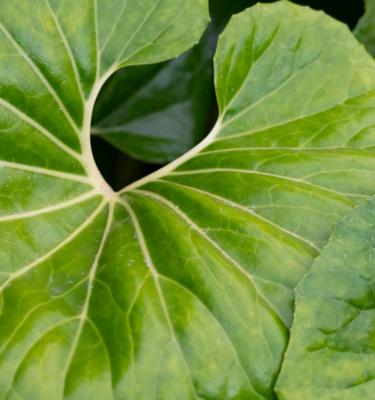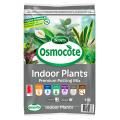

How to grow & care for a Tractor Seat Plant
Tractor Seat (Ligularia dentata reniformis) gets its name from its dark green, glossy tractor seat shaped leaves. You can grow this Japanese native plant both indoors or outdoors - it prefers bright, but indirect sun or dappled shade. Direct morning sunlight is ok, but avoid planting them in a spot with direct hot, afternoon sun. Too much full sun can cause the leaves to wilt or burn.
Tractor Seat plants will grow in a wide range of climates, from the tropics to frost free temperate zones. They prefer a consistently moist soil, so improve the soil well before planting with plenty of compost and make sure you’ve got an irrigation system installed or you can regularly water them during periods of dry heat.
In warmer climates these plants are evergreen, however in cooler regions your plant will die back during winter and re-emerge with the warmth of spring. As your Tractor Seat plants mature they’ll form a clump - which can be divided if they grow too large for your space. Plants can grow up to 70-100cm tall. In summer Tractor Seat plants will produce small, yellow flowers on long stems
If you’re growing them in pots choose a premium potting mix like Scotts Osmocote Premium Potting Mix for Indoor Plants and position the pot in a spot with bright, indirect light for maximum growth. Keep them away from cold, drying drafts - like air-conditioning vents and group them together with other plants to increase the humidity around them.
Top 5 steps to growing Tractor Seat plant
- Tractor Seat plants love a semi-shade or morning sun spot outdoors or grow them indoors in a bright spot with indirect light.
- Grow Tractor Seat plants in frost free climates, from temperate regions to the tropics.
- Tractor Seat plants prefer a rich, consistently moist soil - improve the soil before planting by adding Scotts Osmocote Compost Premium Soil Improver.
- If growing indoors in pots choose a premium potting mix like Scotts Osmocote Premium Potting Mix for Indoor Plants
- Prune off spent flowers or dead leaves towards the base of the plant to encourage new growth
Shopping List
- A Tractor Seat plant
- Scotts Osmocote Compost Premium Soil Improver
- Scotts Osmocote Controlled Release Fertiliser: Garden Beds
- Garden shovel
- Mulch
- Defender Snail & Slug Pellets
- If growing indoors in pots, you’ll need: Scotts Osmocote Premium Potting Mix for Indoor Plants + Scotts Osmocote Controlled Release Fertiliser for Indoor Plants and a suitable pot or container
Preparation & Planting in the garden
Tractor Seat plants can be grown outdoors in the tropics, subtropics or a cooler, but frost free climate. They prefer a part shade or morning sun spot in a moist, but well drained soil, that’s been enriched with plenty of compost.
Prepare the site for planting Tractor Seat plants by mixing a little Scotts Osmocote Compost Premium Soil Improver through the original soil - use a garden shovel to turn it through the top 20-30cm. Dig the planting hole, in this prepared soil, twice as wide as the original nursery pot and the same depth.
Gently remove the Tractor Seat plant from the nursery pot and plant it into your prepared hole, back-fill around the root ball with more soil. Water in well and mulch to suppress weeds and retain moisture.
Planting in pots
Tractor Seat plants can be grown in pots or planters - choose one that is twice the size of the original nursery pot so the plant has room to grow. Make sure your chosen pot has drainage holes too.
Half fill your pot or planter with Scotts Osmocote Premium Potting Mix for Indoor Plants (or use Scotts Osmocote Premium Potting Mix if for an outdoor potted display). Gently remove the Tractor Seat plant from the nursery pot and tease the roots lightly if they are compact. Plant it into the centre of your pot and backfill around the root ball with more potting mix. Water in well and top the soil with mulch to retain moisture.
Remember to keep your Tractor Seat plant well watered, particularly during the warmer months.
If you’re keeping your potted Tractor Seat plant indoors, put it in a warm, bright (but indirect sun) part of your home.
Fertilising & Care
Fertilise using Scotts Osmocote Controlled Release Fertiliser: Garden Beds for in-ground Tractor Seat plants or for potted or indoor Tractor Seat plants use Scotts Osmocote Controlled Release Fertiliser for Indoor Plants. Apply fertiliser in spring and again in autumn.
Prune off any dead or damaged leaves throughout the year at the base of each stem and do the same with spent flowers at the end of summer.
Pests & Diseases
Tractor Seat plants are relatively pest and disease free, except they are very susceptible to slug and snail damage on their large leaves. To control slugs and snails around your Tractor Seat plants sprinkle Defender Snail & Slug Pellets around your plants on a regular basis.
ALERT - Tractor Seat plant is poisonous to both pets and children.
The best time (month) of year to plant? Year round or in spring or autumn in milder climates
The best time (month) to harvest? NA
How often to fertilise - twice a year in spring and autumn
Best location in the garden - morning sun to part shade or indoors in a bright spot with indirect sun




